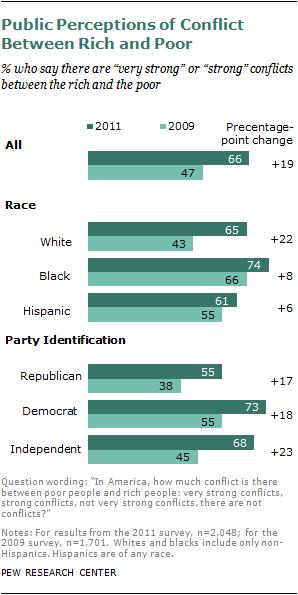
The Occupy Wall Street movement no longer occupies Wall Street, but the issue of class conflict has captured a growing share of the national consciousness. A new Pew Research Center survey of 2,048 adults finds that about two-thirds of the public (66%) believes there are “very strong” or “strong” conflicts between the rich and the poor—an increase of 19 percentage points since 2009.
Not only have perceptions of class conflict grown more prevalent; so, too, has the belief that these disputes are intense. According to the new survey, three-in-ten Americans (30%) say there are “very strong conflicts” between poor people and rich people. That is double the proportion that offered a similar view in July 2009 and the largest share expressing this opinion since the question was first asked in 1987.
As a result, in the public’s evaluations of divisions within American society, conflicts between rich and poor now rank ahead of three other potential sources of group tension—between immigrants and the native born; between blacks and whites; and between young and old. Back in 2009, more survey respondents said there were strong conflicts between immigrants and the native born than said the same about the rich and the poor.1
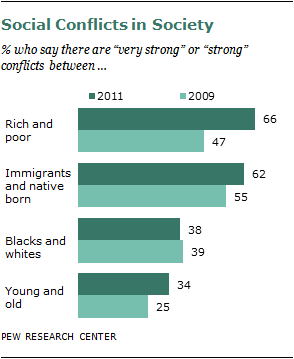
Virtually all major demographic groups now perceive significantly more class conflict than two years ago. However, the survey found that younger adults, women, Democrats and African Americans are somewhat more likely than older people, men, Republicans, whites or Hispanics to say there are strong disagreements between rich and poor.
While blacks are still more likely than whites see serious class conflicts, the share of whites who hold this view has increased by 22 percentage points, to 65%, since 2009. At the same time, the proportion of blacks (74%) and Hispanics (61%) sharing this judgment has grown by single digits (8 and 6 points, respectively).
The biggest increases in perceptions of class conflicts occurred among political liberals and Americans who say they are not affiliated with either major party. In each group the proportion who say there are major disagreements between rich and poor Americans increased by more than 20 percentage points since 2009.
These changes in attitudes over a relatively short period of time may reflect the income and wealth inequality message conveyed by Occupy Wall Street protesters across the country in late 2011 that led to a spike in media attention to the topic. But the changes also may also reflect a growing public awareness of underlying shifts in the distribution of wealth in American society.2 According to the most recent U.S. Census Bureau data, the proportion of overall wealth—a measure that includes home equity, stocks and bonds and the value of jewelry, furniture and other possessions—held by the top 10% of the population increased from 49% in 2005 to 56% in 2009.
Perceptions of the Wealthy
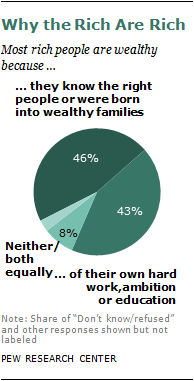
While the survey results show a significant shift in public perceptions of class conflict in American life, they do not necessarily signal an increase in grievances toward the wealthy. It is possible that individuals who see more conflict between the classes think that anger toward the rich is misdirected. Nor do these data suggest growing support for government measures to reduce income inequality.
In fact, other questions in the survey show that some key attitudes toward the wealthy have remained largely unchanged. For example, there has been no change in views about whether the rich became wealthy through personal effort or because they were fortunate enough to be from wealthy families or have the right connections.
A 46% plurality believes that most rich people “are wealthy mainly because they know the right people or were born into wealthy families.” But nearly as many have a more favorable view of the rich: 43% say wealthy people became rich “mainly because of their own hard work, ambition or education,” largely unchanged from a Pew survey in 2008.
About the Survey
This report is based on findings from a Pew Research Center telephone survey conducted with a nationally representative sample of 2,048 adults ages 18 and older living in the continental United States, including 808 adults ages 18 to 34. A total of 769 interviews were completed with respondents contacted by landline telephone and 1,279 with those contacted on their cellular phone. The data are weighted to produce a final sample that is representative of the general population of adults in the continental United States. Survey interviews were conducted under the direction of Princeton Survey Research Associates International, in English and Spanish.
• Interviews conducted December 6-19, 2011 • 2,048 interviews • Margin of sampling error is plus or minus 2.9 percentage points for results based on the total sample and 4.4 percentage points for adults ages 18 to 34 at the 95% confidence level.
[ing]
Social Conflict in American Life
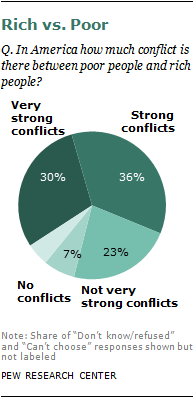
About two-thirds of the public say there are strong conflicts between the rich and the poor, and nearly half of these (30%) say these conflicts are “very strong.” An additional 36% say these differences are “strong,” while 23% view them as “not very strong.” Only 7% say there are no conflicts between rich and poor Americans, while the remainder does not offer an opinion.
Three other historic social divisions are viewed as less pervasive or contentious. About six-in-ten (62%) say there are strong conflicts between immigrants and the native born, including 24% who characterize these disagreements as “very strong.”
That represents a major change from the Pew Research Center survey conducted in 2009. At that time, a larger share of Americans believed that there were more strong conflicts between immigrants and the native born than between rich and poor people (55% vs. 47%). Today, even though perceptions of disagreements between immigrants and the native born have increased by 7 percentage points in the past two years, this social divide now ranks behind rich-poor conflicts in the public’s hierarchy of social flashpoints.
Two other social divides are viewed as less pervasive or intense. Fewer than four-in-ten (38%) say there are serious conflicts between blacks and whites, including 10% who see these conflicts as being “very strong.” About a third say there are similar disagreements between the young and old (34%, a 9-point increase since 2009).
Income and Perceptions of Class Conflict
The perception that strong and growing conflicts exist between the economic classes is broadly held. Not only do those at the bottom rungs of the income scale agree that there are serious disagreements between the economic classes, but even those who are relatively well-off hold that belief.
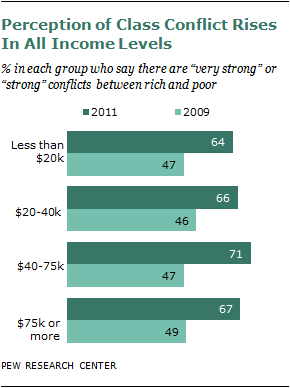
Nearly two-thirds (64%) of all adults with family incomes of less than $20,000 a year report serious conflicts between the rich and poor—a view shared by 67% of those earning $75,000 a year or more.
Moreover, the perceptions of class conflicts have grown in virtual lock step across all income groups since 2009, rising by 17 percentage points among those earning less than $20,000 and by 18 points among those making $75,000 or more.
The increase is slightly larger among middle-income Americans earning between $40,000 and $75,000. Among this group, the share who say there are strong class conflicts increased by 24 points, from 47% in 2009 to 71% in the latest survey.
Other Demographic Differences
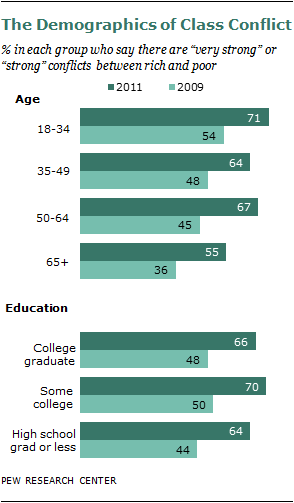
Young people ages 18 to 34—the demographic group most closely associated with the Occupy movement—is more likely than those 35 or older to see “strong” conflicts between the rich and poor. According to the survey, more than seven-in-ten (71%) of these young adults say there are major disagreements between the most and least affluent, a 17 percentage point increase since 2o09.
Baby Boomers ages 50 to 64—the mothers and fathers of the Occupy generation—are nearly as likely to say there are serious conflicts between the upper and lower classes; fully two-thirds (67%) say this, a 22-point increase in the past two years. Among those ages 35 to 49, more than six-in-ten (64%) see serious class conflicts.
While older adults are the least likely to see serious disagreements between the classes, the proportion who express this view increased from 36% two years ago to 55% in the current survey.
Women are more likely than men to say there are serious disagreements between the rich and poor (71% vs. 60%). In 2009, about half of all women (51%) and 43% of men said there was strong conflict between the classes.
Perceptions of Class Conflict Surge among Whites
In the past two years, the proportion of whites who say there are strong conflicts between the rich and the poor has grown by 22 percentage points to 65%. That is more than triple the increase among blacks or Hispanics. The result is that the “perceptions gap” between blacks and whites on class conflict has been cut in half, while among Hispanics the difference has disappeared and may have reversed.
In the latest survey, the difference in the share of blacks and whites who say there are strong conflicts between rich and poor stands at 9 percentage points (74% for blacks vs. 65% for whites). In 2009 the black-white divide on this question stood at 23 percentage points (66% vs. 43%).
Among Hispanics, the gap has closed and may have reversed: In 20o9, the share of Hispanics who said there were serious conflicts between the economic classes was 12 points larger than the share of whites (55% vs. 43%). Today, the proportion of whites who say there are serious disagreements is 4 percentage points greater than the share of Hispanics who hold the same view (65% for whites vs. 61% for Hispanics), though this difference is not statistically significant.
The Politics of Class Conflict
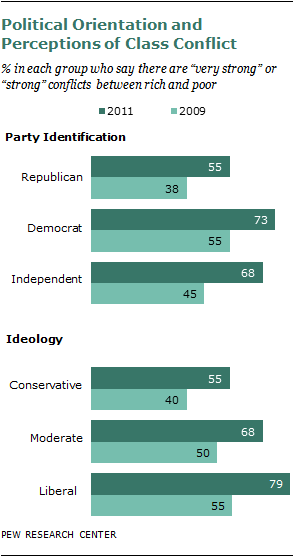
Democrats and political liberals are far more likely than Republicans or conservatives to say there are major conflicts between rich people and poor people.
At the same time, in just two years the perceptions of class conflict have increased significantly among members of both political parties as well as among self-described independents, conservatives, liberals and moderates.
The result is that majorities of each political party and ideological point of view now agree that serious disputes exist between Americans on the top and bottom of the income ladder.
Nearly three-quarters of self-described Democrats (73%) say there are serious class conflicts, an 18 percentage point increase over those who said that in 2009. The increase among Republicans was about as large (17 percentage points); currently a majority of GOP partisans see serious conflicts between rich and poor.
Views of class conflicts increased the most among political independents, swelling by 23 percentage points to 68% in the current survey. Two years ago, fewer than half of all independents said there were major disagreements between the classes.
Similarly, perceptions of class conflict among ideological liberals increased by 23 percentage points to 79% in the past two years while rising less quickly among conservatives (15 points) or moderates (18 points).
How the Rich Got Wealthy
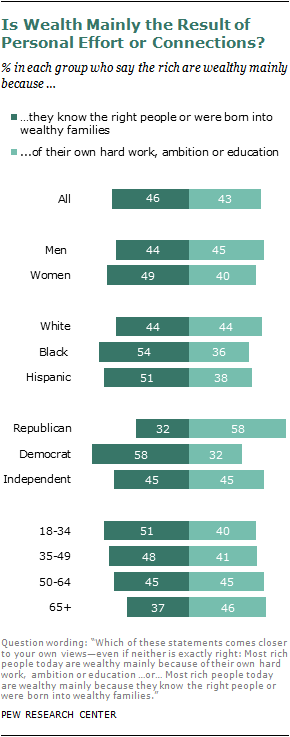
Americans divide nearly evenly when they are asked if the rich became wealthy mostly due to their own hard work or mainly because they were born into a wealthy family or had connections.
A narrow plurality (46%) believes the rich are wealthy because they were born into money or “know the right people.” But nearly as many (43%) say the rich got that way because of their own “hard work, ambition or education.”
The latest result is virtually identical to the findings of a 2008 Pew survey. It found that 46% of the public believed that riches are mostly the result of having the right connections or being born into the right family, while 42% say hard work and individual characteristics are the main reason the rich are wealthy.3
These competing explanations of wealth are cited by roughly equal shares of all income groups. According to the latest Pew survey, 46% of those with family incomes of less than $20,000 a year believe that luck and connections explain most wealth, a view shared by 47% of those with family incomes of $100,000 or more.
In contrast, attitudes of Republicans and Democrats on this issue are mirror opposites of each other. Nearly six-in-ten Democrats (58%) say wealth is mainly due to family money or knowing the right people. An identical proportion of Republicans say wealth is mainly a consequence of hard work, ambition or having the necessary education to get ahead. Political independents fall in between: slightly less than half (45%) credit personal effort, while an equal share believe family circumstances or connections is the most likely explanation.
African Americans (54%) are more likely than non-Hispanic whites (44%) to see wealth as a consequence of family money or connections, a view shared by 51% of Hispanics. Women in the survey are slightly more likely than men to say wealth is the result of family or connections but these differences are not statistically significant.
Young people are significantly more likely than older adults to believe most wealth is due to family money or connections (51% for those ages 18-34 but 37% for adults 65 or older). However, the views of the “younger young”—those 18 to 25—differ significantly from those who are just a few years older.
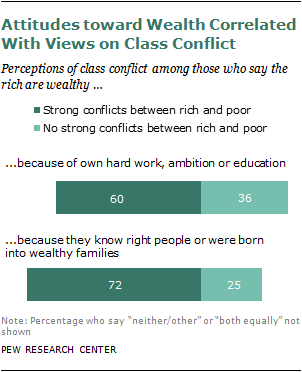
According to the survey, less than half (47%) of those 18 to 25 say the rich are wealthy because of reasons other than personal effort or drive, or about equal to the proportion of those 35 or older who share this view. In contrast, a majority (55%) of those 26 to 34 say being born into a wealthy family or personal connections are the main reasons that people are rich.
Views on Wealth, Class Conflict
Attitudes toward the wealthy—specifically, how the rich got that way—are somewhat correlated with views on class conflict.
According to the survey, those who believe the rich acquired their fortunes mainly through their own efforts are significantly less likely than those who hold the contrary view to say there are strong conflicts between the classes (60% vs. 72%).




